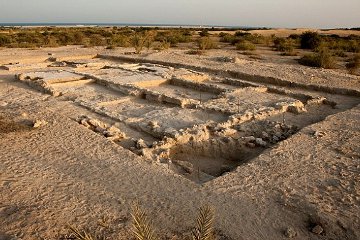Arabian Christians
| Sir Bani Yas | 24 19 43.08N 52 33 43.61E | It is possible that these are the coordinates for the actual site, but I can't be sure. |
Some years ago I was on a flight to Bahrain and my seatmate was a gentleman who worked in Saudi Arabia. Learning that I was interested in archaeology, he began to tell me of an excavation conducted near his workplace by Saudi archaeologists. To their horror, they had uncovered the remains of a Christian church - he was unable to give me any dates for this church, but he did say that he had viewed it and been shown round by the archaeologists working on the site.
The horror was due to the belief that before Islam came, the Arabs were in a start of heathen anarchy, known to the Muslims as the time of Ignorance. Once Mohammed delivered his revelations, the Arabs turned to embrace Islam. The discovery that at least some of the Arabs were Christians implied that the Ignorance wasn't all that it was claimed to be, and that the unanimity with which Islam was accepted was less comprehensive than Muslim mythology would like. (Remember that Osama bin Laden started his rumpus because he was offended by the presence of Christian Americans in the Arabian peninsula!)
In the west we would nod, write a few papers, and move on with our view of history modified. Truth, alas, is not a Muslim priority and is treated with considerable flexibility. The church was hastily covered with sand and the archaeologists dispersed to other sites. The discovery did not feature in any reports of that year's excavations and when he made enquiries about it, officials blandly denied that any excavations had taken place in the area and therefore no church could possibly have been found!

| |
| The ruins of a Nestorian monastery on the island of Sir Bani Yas, before they were preserved by the Abu Dhabi authorities. |
It is very much to the credit of Abu Dhabi, therefore, that the discovery of a Christian monastery that pre-dates Mohammed has been made public. Unearthed in 1992, the site is on Sir Bani Yas island off the coast of Abu Dhabi and consists of the foundations of a church, a protective tower and a small chapel. The buildings were richly decorated with moulded tiles in floral and geometric patterns. The size of the buildings indicate that the monastery may have housed between 30 and 40 monks.
We know that the building is a monastery, not just because of the way the building was arranged, but by the crosses moulded into the plaster in some of the rooms and a niche for holy water in the church. The discovery of cooking pots and other personal items indicate that there was a permanent presence at the site rather than just worshippers meeting once a week.
The limited excavation has not uncovered a cemetery, even though we know that the area has been inhabited since around 5,500 BC (conventional chronology) and the monastery was in use until around AD 750. However the excavators did discover one skeleton - right in the heart of the church! This led the archaeologists to suggest that the church was built around this tomb and the man buried there may have been the founder of the monastery or a saint whose grave attracted pilgrims from as far away as India.
Although no evidence has been found on the site, it is likely that these Christians were Nestorians, for the Nestorians had a strong missionary impulse towards the east, with missionaries taking their version of Christianity as far as China. Historical records speak of a certain Jonah, who lived around AD 345 and settled on the "black island", which was located south of "Bet Qatraye" - in other words, south of Qatar. In the absence of written evidence from the site we cannot be certain, but it is tempting to suggest that the single skeleton may be that of the venerable Jonah - or at least, that it was thought to be his!
When excavations concluded in 1995 the site was covered with sand, ostensibly to preserve it: I suspect that there was an intense debate going on behind the scenes over what to do with the inconvenient discovery. It took the personal intervention of Sheikh Mohammed bin Zayed, ruler of Abu Dhabi, to get the Abu Dhabi authorities to make up their minds and decide to put the site on official display. They have built a steel roof over it and installed display boards, as well as authorising guides. They are also continuing work on the site in the hope of learning more about this outpost of Christianity.
In particular historians are intrigued by the fact that the monastery continued in existence for at least a century after Islam spread across the peninsula and ended up being deserted, not destroyed. In other words, unlike the mythology encouraged by the Saudis and so firmly believed by Osama, Christians and Muslims lived and worshipped peacefully side by side in Arabia long after Mohammed had preached his message. Archaeology shows that intolerance is not an integral part of Islam but is a modern deviation. Saudi Wahabis may not like it, but it's a fact!
Sir Bani Yas The island, which is named after the Bani Yas tribe, one of the largest tribes on the Arabian peninsula, has been made into a tourist resort, offering not only swimming and diving in the clear waters of the Persian Gulf, but there is a wild life park featuring endangered species of gazelle, oryx, ostrich and a wide variety of native birds. The authorities have undertaken an extensive programme of tree planting, which forms a marked contrast to the desert that makes up most of the island. Return
© Kendall K. Down 2010





